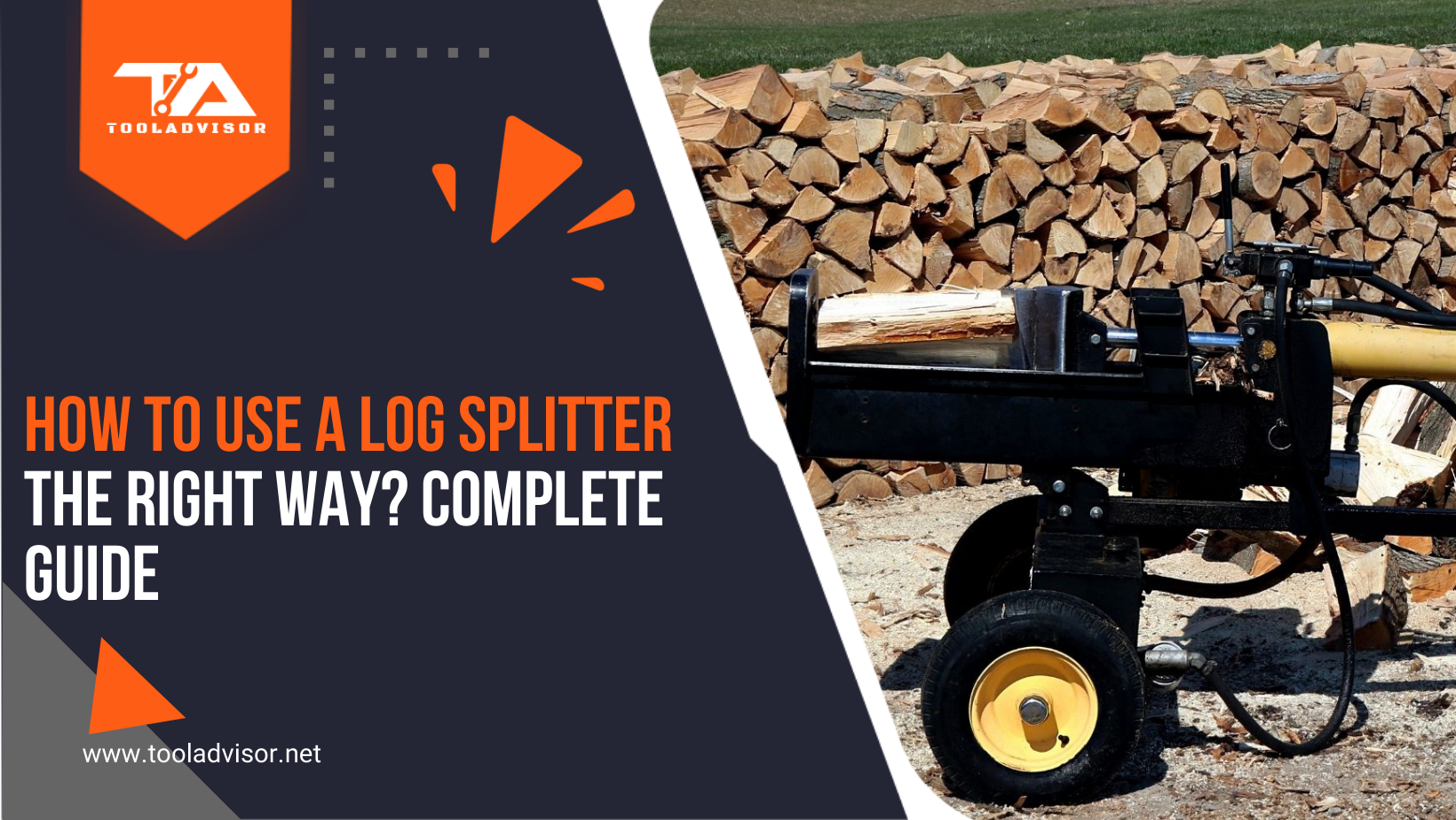Have you ever been cutting your firewood and thought, “Man, this is a lot of work”? If so, then you should invest in a log splitter. This machine will make your life much easier during the winter months when it’s time to start cutting up logs for heat.
Still, many people find the time to split logs for their home heat or fires because they enjoy the satisfaction of knowing they survived winter with their beloved wood stove intact. If log splitting is something you want to try your hand at this year but are unsure how to do so safely and efficiently, read on!
We’ve got some great tips for using a log splitter correctly.
Types Of Log Splitters
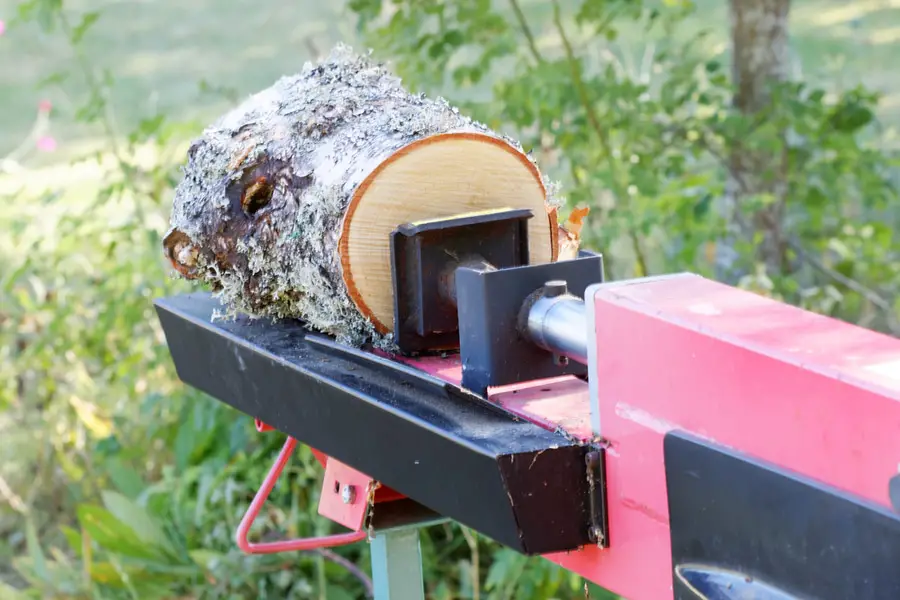
Before we dive into how to use a log splitter properly, it’s important to understand the different types of splitters available on the market.
Manual Log Splitter
The log splitter shown here is a small, light machine. It’s easier to store and use than other types of log splitters. You can choose between a foot-powered or hand-powered model depending on your preferences. Some manual log splitters are powered by hydraulics, while others need human or weight power.
A manual log splitter requires more effort, but it is still more practical than swinging an ax. Manual splitter is ideal for individuals who only burn wood on rare occasions and don’t want to spend extra for an electrical version.
Electric Log Splitter
The most popular type of splitter on the market is an electric log splitter, which is adequate for most applications. These tools operate on the same gas types, essentially.
The most important distinction is that an electric motor is used to power the hydraulics instead of a gasoline engine. Because of their tiny size, electric versions are lighter and more portable. The machine can be set up on a stand or even a ground-level bench.
The main benefit of utilizing an electric log splitter is that it may be used indoors, outside, or even in remote locations as long as there is access to a standard outlet. Because you won’t have to worry about changing fluids or maintaining a gas engine, this machine requires less upkeep.
Gas Log Splitters
The most powerful log splitter is the gas-powered log splitter, which is used for heavy-duty operations. These devices are used to split bigger logs. Electric models don’t have to be plugged into an outlet because they don’t emit engine fumes, but you can’t utilize them inside because of their exhausts.
Because of their robust design, gas-driven splitters are also the most powerful. On the other hand, these devices need regular maintenance, just like any other piece of equipment with a gasoline engine.
Spark plug replacements, oil changes, and fuel additions regularly are all part of routine maintenance. A gas log splitter is perfect for any sort of usage and is best suited for everyone, from people who intend to cut wood regularly to those who only want to use their gas logs occasionally.
However, because these machines cannot be used indoors in inclement weather, you may need to purchase an electrical log splitter for use on short notice.
If you know, you’ll be splitting hardwood all year, and even if the seasons change, a gas splitter is your best bet. Depending on how busy you are, maybe you’ll wind up investing in more than one gas splitter.
How To Use A Log Splitter?
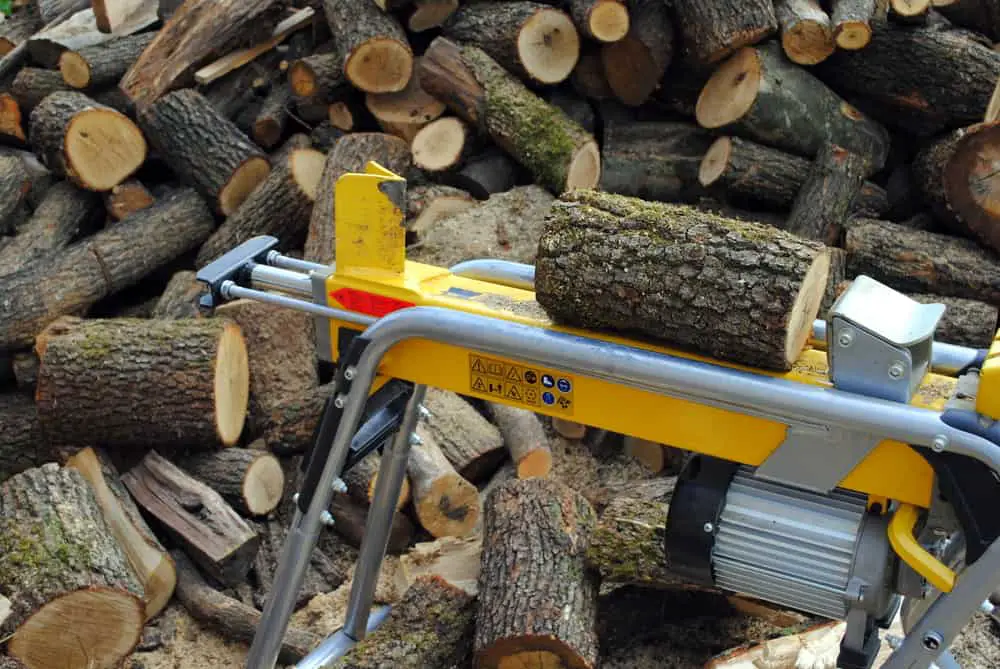
You’ll need to choose between a gas or electric model, depending on your personal preference and workload. A hydraulic log splitter is the most efficient log splitter you can use, regardless of whether you choose a gas or electric version. This useful tutorial will show you how to operate the equipment correctly.
Follow these simple steps once you’ve gathered all of the necessary materials.
1. Take Proper Safety Precautions
Before making a single cut, it is crucial to wear the proper safety equipment. Make sure you have eye protection and gloves to shield your hands from flying splinters at all times.
In addition, do not operate a log splitter in wet conditions, especially if the machine has an electric motor that isn’t waterproof. You may be electrocuted if you use the machine in damp weather.
2. Position the Splitter
Place the splitter as close to the log as possible, with the blade just touching the end of the wood. This will minimize the amount of force needed to split the wood. If you position the machine too far away from the log, it will be more challenging to push, and the log may not split in half.
3. Ensure The Splitter Is Positioned Correctly
Make sure the log is entirely on top of the platform you’re using. It can’t be hanging off by even an inch, or the blade may not make contact with it, preventing it from cutting through completely.
4. Switch On The Machine
Once the log is positioned correctly, you’ll need to turn on the machine. Most devices have an electronic switch or a trigger mechanism that needs to be pressed in order to activate.
5. Load The Splitter
Once the machine is on, slowly feed the log into the blade. Make sure you see where it’s going, or you may wind up cutting yourself with flying wood chips.
6. Cut The Log
After feeding about half of the log through, let go and allow it to be cut entirely in half by the blade. Take your time when doing this; if you try to rush, you could end up hurting yourself or damaging the equipment.
If the log is particularly large, it may not split in half on the first try. In this case, you can either reposition the log and try again or use a wedge to help break it apart.
7. Remove The Split Log
Finally, use a pry bar or another lever to remove the two halves of wood from the splitting platform. Make sure you wear gloves when doing this because splinters of wood may still be sticking out and can injure you.
Safety Tips You Should Keep In Mind When Using Log Splitter
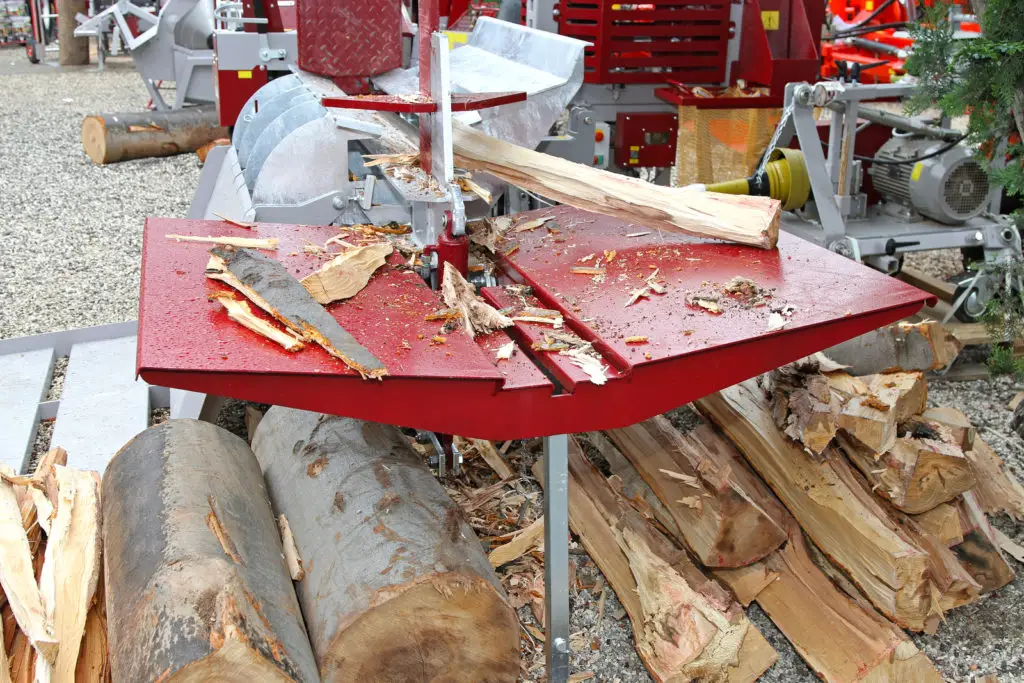
As you can see from the steps above, using a log splitter can be a breeze as long as you take precautions before operating it. Since these machines are heavy and cumbersome, be sure that you have a spotter available to help you just in case something goes wrong.
In addition, keep these safety tips in mind at all times:
Determine The Kind Of Wood You Are Working On
Different types of wood require different techniques to split effectively. For instance, oak is a tough wood and will require more brute force than a softwood like pine.
Never operate the machine when you are tired or feeling ill: You need to be alert when using a log splitter in order to avoid potential injuries.
Be Prepared To Give It Your All
Making the first cut is the hardest part of splitting wood. As soon as you see that it’s halfway through, let go and allow gravity to do its job. Splitting wood is very strenuous; make sure you take short breaks in between, helping to avoid straining your back or hurting yourself in another way.
Adjust The Height Of The Log Splitter
If you’re having a difficult time pushing the log through, try adjusting the height of the machine. This will put less pressure on your arms and back.
Pay Close Attention
Working with a partner is fine, but make sure you both agree on the terms of the relationship. If one person tries to boss another around or is reckless, be sure to intervene and stop it immediately.
|
PRO-TIP – Do not use the machine in wet weather conditions. This will increase your risk of getting electrocuted or catching fire. |
|---|
Read The Manual
Read the manual if you do not know how to operate a particular machine. It will explain things in detail and provide handy safety tips that you should always keep in mind when using any power equipment.
Wear The Right Clothing
In order to avoid getting injured, wear clothing that will protect your skin in case of an accident. This includes long pants, a long-sleeve shirt, and closed-toe shoes. Eye protection is also a must when using a log splitter.
Log Splitter Maintenance Tips
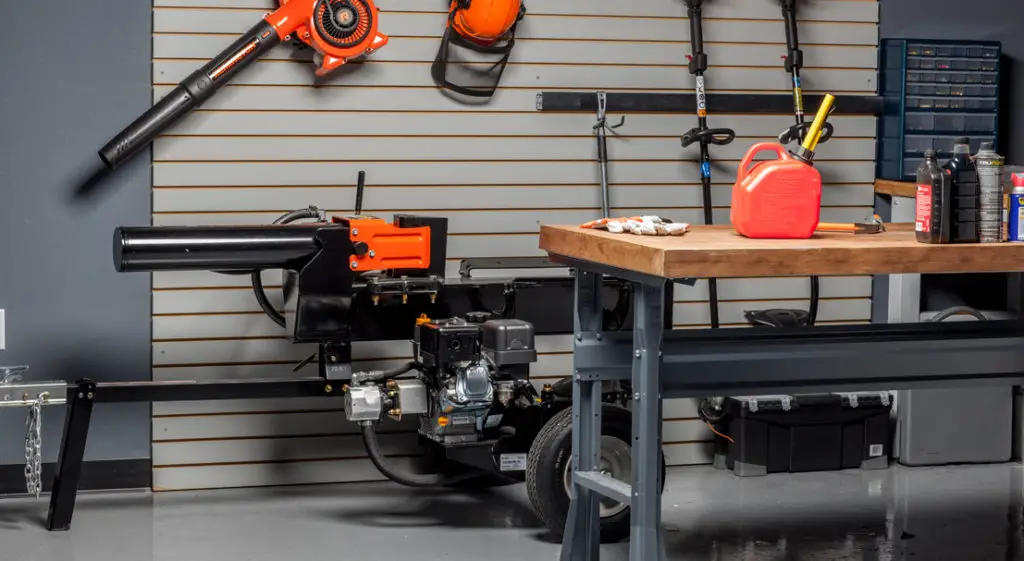
When you take care of your log splitter, it will return the favor by providing you with dependable service for many years to come. Here are some helpful tips to keep in mind when performing routine maintenance on this type of machine:
Check The Hydraulic Pipes Before Each Use
Stop and inspect the hydraulic pipes immediately if you notice any leaks, rattling noises, or other unusual sounds. This will prevent any severe damage from occurring to your machine.
Remove Fuel
Fuel can go bad over time, which reduces the efficiency of your machine. Never use a log splitter that has been sitting for more than six months.
Discard Air From The Cylinder
Before using the machine, press the hydraulic levers down and then release them slowly to expel air from your log splitter’s cylinder.
Regularly Sharpen The Blades
You should also sharpen your blades to improve performance and get the most out of each use.
Use The Right Oil:
The type of oil you use is very important too. Petroleum-based oils will reduce the life of your machine. Make sure you only use synthetic or semi-synthetic hydraulic fluid because it has a low viscosity and does not contain any volatile organic compounds (VOCs).
Store The Splitter In An Appropriate Place
Make sure you store your machine in a clean and dry area where it will not be exposed to the elements. This will also help prevent any damage from occurring due to rust and corrosion.
Clean The Log Splitter Regularly
Properly caring for your log splitter will extend its life. Clean it after each use, especially if you’ve used it to cut wet wood because this increases the risk of corrosion and rust.
Replace Worn Out Parts
If you find any worn-out or broken parts, immediately take care of the situation. Never operate a machine that has something visibly wrong because this can lead to injury and damage to your machine.
Service Gas Engines At Least Annually
If you have a gas engine, it’s important to have it serviced at least once a year. This will help keep it running in top condition and prevent any potential problems from arising.
Keep A Fire Extinguisher On-Hand
It’s important to have one of these on hand for emergencies because this type of power equipment may cause fires.
By following these simple maintenance tips, you can keep your log splitter in good working condition for many years to come.
Log Splitter FAQs
How can I speed up my log splitter?
If you want to cut wood faster, you can use an ax and a sledgehammer to split the log first. This will reduce the number of times your machine has to work.
Does a log splitter need level ground?
No, a log splitter does not need to be on level ground in order to operate. However, it will be easier to use if the ground is flat.
How much pressure should a log splitter have?
There is no set amount of pressure that a log splitter should have. It depends on the size and type of log you are trying to split. However, 30 psi is usually sufficient.
What oil should I use in my wood splitter?
Hydraulic oil with a 10W (Winter) weight rating is required for gas log splitters. This hydraulic oil type nourishes moving elements and other mechanical components during bitter cold and scorching heat, preventing them from wearing.
In Conclusion
As you can see, there are a few key things to remember when using a log splitter for your home. Be sure to take it slow and use caution at all times – no matter how much experience you have splitting logs with.
In any case, make sure you don’t leave the work up to a single person or endanger yourself by working in bad weather conditions. Hopefully, this article has helped shed some light on the right way to use a log splitter. Happy splitting!
